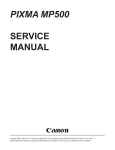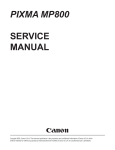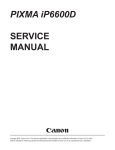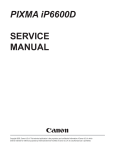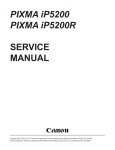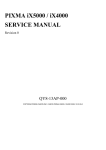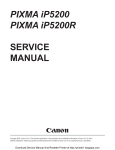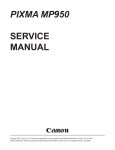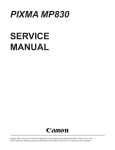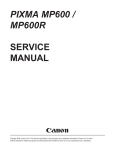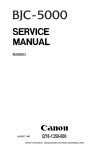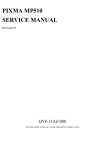Download Canon iP4200 - PIXMA Photo Printer Service manual
Transcript
PIXMA iP4200
SERVICE MANUAL
Revision 0
QY8-13A9-000
COPYRIGHT©2005 CANON INC. CANON PIXMA iP4200 072005 XX 0.00-0
Scope
This manual has been issued by Canon Inc., to provide the service technicians of this product with the information
necessary for qualified persons to learn technical theory, installation, maintenance, and repair of products. The manual
covers information applicable in all regions where the product is sold. For this reason, it may contain information that is
not applicable to your region.
Revision
This manual could include technical inaccuracies or typographical errors due to improvements or changes made to the
product. When changes are made to the contents of the manual, Canon will release technical information when
necessary. When substantial changes are made to the contents of the manual, Canon will issue a revised edition.
The following do not apply if they do not conform to the laws and regulations of the region where the manual or product
is used:
Trademarks
Product and brand names appearing in this manual are registered trademarks or trademarks of the respective holders.
Copyright
All rights reserved. No parts of this manual may be reproduced in any form or by any means or translated into another
language without the written permission of Canon Inc., except in the case of internal business use.
Copyright © 2005 by Canon Inc.
CANON INC.
Inkjet Device Quality Assurance Div. 2
451, Tsukagoshi 3-chome, Saiwai-ku, Kawasaki-shi, Kanagawa 212-8530, Japan
I. MANUAL OUTLINE
This manual consists of the following three parts to provide information necessary to service the PIXMA iP4200:
Part 1: Maintenance
Information on maintenance and troubleshooting of the PIXMA iP4200
Part 2: Technical Reference
New technology and technical information such as FAQ's (Frequently Asked Questions) of the PIXMA iP4200
Part 3: Appendix
Block diagrams and pin layouts of the PIXMA iP4200
Reference:
This manual does not provide sufficient information for disassembly and reassembly procedures. Refer to the graphics in
the separate Parts Catalog.
II. TABLE OF CONTENTS
Part 1: MAINTENANCE
1. MAINTENANCE
1-1. Adjustment, Periodic Maintenance, Periodic Replacement Parts, and Replacement Consumables by
Service Engineer
1-2. Customer Maintenance
1-3. Product Life
1-4. Special Tools
1-5. Serial Number Location
2. LIST OF ERROR DISPLAY / INDICATION
2-1. Operator Call Errors
2-2. Service Call Errors
2-3. Warnings
2-4. Troubleshooting by Symptom
3. REPAIR
3-1. Notes on Service Part Replacement (and Disassembling / Reassembling)
3-2. Special Notes on Repair Servicing
3-3. Adjustment / Settings
(1) Paper feed motor adjustment
(2) Grease application
(3) Waste ink counter setting
(4) User mode
(5) Service mode
Service test print, EEPROM initialization, Waste ink counter reset
Destination settings
3-4. Verification Items
(1) Service test print
(2) EEPROM information print
4. PRINTER TRANSPORTATION
Part 2: TECHNICAL REFERENCE
1. NEW TECHNOLOGIES
2. CLEANING MODE AND AMOUNT OF INK PURGED
3. PRINT MODE
4. FAQ (Problems Specific to the iP4000 and Corrective Actions)
Part 3: APPENDIX
1. BLOCK DIAGRAM
2. CONNECTOR LOCATION AND PIN LAYOUT
2-1. Logic Board Ass'y
2-2. Carriage Board (Print Head Connector)
PIXMA iP4200 Specifications
Part 1
MAINTENANCE
1. MAINTENANCE
1-1. Adjustment, Periodic Maintenance, Periodic Replacement Parts, and
Replacement Consumables by Service Engineer
(1) Adjustment
Adjustment
Timing
Purpose
Tool
Approx.
time
Destination
settings
(EEPROM
settings)
At logic board replacement
To set the destination.
None.
Perform in the
service mode.
1 min.
Waste ink
counter
resetting
(EEPROM
settings)
- At logic board replacement
- At waste ink absorber
replacement
To reset the waste ink counter.
None.
Perform in the
service mode.
1 min.
Paper feed
motor position
adjustment
At paper feed motor
replacement
To adjust the belt tension.
(Position the paper feed motor so
that the belt is stretched tight.)
None.
5 min.
CD / DVD
- At logic board replacement
detection sensor - At carriage unit replacement
light volume
correction*1
To correct the light volume for
the CD / DVD detection sensor.
None.
Perform in the
service mode.
2 min.
Grease
application
- At carriage unit replacement
- At PR shaft ass'y replacement
- At CL base / gear replacement
- To maintain sliding properties
of the carriage shaft and the lift
cam shaft.
- To protect the printer's sliding
portions (gears).
FLOIL KG-107A
1 min.
Ink system
function check
- At logic board replacement
- At platen unit replacement
- At carriage unit replacement
To maintain detection
functionality for presence of the
ink tanks and each ink tank
position.
None.
Perform in the
service mode.
1 min.
1-1
Note: DO NOT loosen the red screws at both ends of the carriage shaft, securing the print head position, as they are
not re-adjustable.
The red screws securing the paper feed motor may be loosened only at replacement of the paper feed motor
unit.
*1: Only for CD / DVD printing supported regions.
(2) Periodic maintenance
No periodic maintenance is necessary.
(3) Periodic replacement parts
There are no parts in this printer that require periodic replacement by a service engineer.
(4) Replacement consumables
There are no consumables that require replacement by a service engineer.
1-2. Customer Maintenance
Adjustment
Timing
Purpose
Tool
Approx.
time
Print head
alignment
At print head replacement.
To ensure accurate dot
placement.
- Printer buttons
- Computer
(automatic settings
via the printer
driver)
3 min.
Print head
cleaning
When print quality is not
satisfying.
To improve nozzle conditions. - Printer buttons
- Computer (settings
via the printer
driver)
1 min.
Print head deep
cleaning
When print quality is not
satisfying, and not improved by
print head cleaning.
To improve nozzle conditions. Computer (settings
via the printer driver)
2 min.
Ink tank
replacement
When an ink tank becomes
empty. ("No ink error" via the
computer, or ink tank LED
flashing fast in red)
-----
-----
2 min.
Paper feed roller When necessary
cleaning
To clean the paper feed
rollers.
Printer buttons
CD / DVD print At CD / DVD printing, when
position
necessary
adjustment
To correct CD / DVD print
position.
Computer (application 5 min.
software)
Bottom plate
cleaning
To clean the platen ribs.
- Plain paper
- Computer (settings
via the printer
driver)
When the back side of the paper
is smeared
2 min.
1 min.
ASF sub- roller
cleaning
When the paper fed from the
ASF is smeared due to ink mist
attached to the ASF sub-rollers.
To clean the ASF sub-rollers.
- Plain paper
- Printer buttons
[See Part 2, 4. FAQ,
How to make and
set the ASF subroller cleaning
sheet, for details]
1-2
1 min.
1-3. Product Life
(1) Printer
Specified print volume (I) or the years of use (II), whichever comes first.
(I) Print volume
PIXMA iP4200: 18,000 pages
Black 1,500 character pattern
8,300 pages
Color A4, 7.5% duty per color pattern
5,400 pages
A4, photo, borderless printing
400 pages
4 x 6, photo, borderless printing
3,200 pages
Postcard, photo, borderless printing
700 pages
(II) Years of use
PIXMA iP4200: 5 years of use
(2) Print head
Print volume: 18,000 pages
Black 1,500 character pattern
8,300 pages
Color A4, 7.5% duty per color pattern
5,400 pages
A4, photo, borderless printing
400 pages
4 x 6, photo, borderless printing
3,200 pages
Postcard, photo, borderless printing
700 pages
(3) Ink tank (target value)
Pattern
Ink tank used
Print yield
PGI-5BK
Approx. 820 pages
Black text
CLI-8BK
Color chart
Photo chart
CLI-8BK
Approx. 2,000 pages
PGI-5BK
Approx. 1,450 pages
CLI-8Y
Approx. 540 pages
CLI-8M
Approx. 600 pages
CLI-8C
Approx. 850 pages
CLI-8BK
Approx. 1,650 pages
CLI-8Y
Approx. 310 pages
CLI-8M
Approx. 290 pages
1-3
CLI-8C
Approx. 430 pages
Black text: When printing the Canon standard pattern (1,500 characters per page) on A4 size plain paper, with
the default settings in the Windows XP driver, using Word 2003.
Color chart: When printing the ISO/JIS-SCID N5 pattern on A4 size plain paper in bordered printing, with the
default settings in the Windows XP driver, using Photoshop 7.0.
Photo chart: When printing the Canon standard pattern on 4" x 6" Photo Paper Plus Glossy in borderless
printing, with the default settings in the Windows XP driver, using Windows XP Photo Printing
Wizard.
The print yield in the table above is an average value measured in continuous printing, using the ink tank
immediately after it is unsealed, until the ink is out. Ink yield may vary depending on texts and photos printed,
application software, print mode, and type of paper used.
1-4. Special Tools
Name
Grease FLOIL
KG-107A
Tool No.
Price
Application
QY9-0057-000
US$2.00
Remarks
To be applied to the sliding portions In
of the carriage shaft and lift cam
common
shaft.
with the
S500
and
S520.
1-5. Serial Number Location
On the carriage flexible cable holder (visible on the right of the carriage after the printer is turned on, the access cover
is opened, and the carriage moves to the center).
To the top
<Part 1: 1. MAINTENANCE>
1-4
2. LIST OF ERROR DISPLAY / INDICATION
Errors are indicated by the LED, and warnings are displayed on the monitor of the computer connected to the printer.
2-1. Operator Call Errors (by Alarm LED Blinking in Orange)
Alarm
LED
blinking
in orange
2 times
3 times
4 times
5 times
Solution
Error [Error code]
No paper. (ASF) [1000]
Set the paper in the ASF, and press the
Resume/Cancel button.
No CD / DVD tray. [1001]*1
Set the CD / DVD tray, and press the
Resume/Cancel button.
No paper in the cassette. [1003]
(No paper in the front paper feed
cassette.)
Set the paper in the cassette, and press the
Resume/Cancel button.
No CD / DVD. [1002]*1
Set a CD or DVD in the CD / DVD tray
(which is ejected at error occurrence), and
insert the CD / DVD tray in the proper
position. Then, press the Resume/Cancel
button.
Paper jam. [1300]
Remove the jammed paper, and press the
Resume/Cancel button.
Remarks
Error in paper
feeding from the
ASF.
Paper jam in the rear guide. [1303]
Error in the duplex
printing unit.
Paper jam in the under guide.
[1304]
Error in paper
feeding from the
cassette.
Front door close error. [1250]
Open the paper output tray.
The error is
indicated if the
paper output tray
is closed at start of
a print job, or
while a print job is
being performed.
No ink. [1600]
Replace the empty ink tank(s), or press the
Resume/Cancel button.
Pressing the
Resume/Cancel
button will exit the
error without ink
tank replacement,
however, ink may
run out during
printing.
Ink tank not installed. [1660]
Install the applicable ink tank(s) properly,
and confirm that the LED's of all the ink
tanks light red.
The print head is not installed
[1401], or it is not properly
installed (Print head temperature
sensor error [1403] / Faulty
EEPROM data of the print head
[1405]).
Install the print head properly.
1-5
6 times
Inner cover open. [1841]*2
Close the inner cover, and press the
Resume/Cancel button.
Inner cover open during printing
on paper. [1846]*2
Close the inner cover, and press the
Resume/Cancel button.
Inner cover open during printing
on paper (print continuable).
[1851]*1
Close the inner cover, and press the
Resume/Cancel button.
Inner cover open during printing
Close the inner cover, and press the
on paper (print NOT continuable). Resume/Cancel button to clear the error.
The paper being printed at error occurrence
[1856]*1
will be ejected without printing the
remaining data for the ejected paper, then
printing will resume from the next page.
Inner cover closed during CD /
DVD printing (print continuable).
[1850]*1
Open the inner cover which functions as the
CD / DVD tray feeder, set the CD / DVD
tray in the feeder, and press the
Resume/Cancel button.
Inner cover closed during CD /
DVD printing (print NOT
continuable). [1855]*1
Open the inner cover, and press the
Resume/Cancel button to clear the error.
The CD or DVD being printed at error
occurrence will be ejected without printing
the remaining data for the ejected CD or
DVD, then the next print job will be done.
Multiple ink tanks of the same
color installed. [1681]
Replace the wrong ink tank(s) with the
correct one(s).
Ink tank in a wrong position.
[1680]
Install the ink tank(s) in the correct
position.
8 times
Warning: The waste ink absorber
becomes almost full. [1700]
Pressing the Resume/Cancel button will
exit the error, and enable printing.
9 times
The connected digital camera or
digital video camera does not
support Camera Direct Printing.
[2001]
Remove the cable between the camera and
the printer.
10 times
Automatic duplex printing cannot
be performed. [1310]
Press the Resume/Cancel button to eject the
paper being used at error occurrence.
Printing will resume from on the front side
of the next page.
Data which was to
be printed on the
back side of paper
at error occurrence
is skipped (not
printed).
11 times
Failed in automatic print head
alignment. [2500]
Press the Resume/Cancel button.
- If paper is being fed at error occurrence,
the error is indicated after the paper is
ejected.
- If the error occurs, the print head
alignment values are not changed.
- After exit from the error by the
The error is
indicated when the
pattern is not
printed due to no
ink or non-ejection
of ink, or when the
sensor's AD value
7 times
1-6
The service call
error, indicating
the waste ink
absorber is full, is
likely to occur
soon.
Resume/Cancel button, the automatic print
head alignment will not be re-done.
is incorrect.
13 times
The remaining ink amount
unknown. [1683]
An ink tank which has once been empty is
installed. Replace the applicable ink tank
with a new one.
Printing with a
once-empty or
refilled ink tank
can damage the
print head.
If printing is
continued without
replacing the "nogood" ink tank,
press the
Resume/Cancel
button for 5 sec. or
longer to record the
use of a refilled ink
tank.
Note:
After the above
operation, the
function to detect
the remaining ink
amount is disabled.
14 times
Ink tank not recognized. [1684]
A non-supported ink tank is installed (the
ink tank LED is turned off). Install the
supported ink tanks.
15 times
Ink tank not recognized. [1410 to
1419]
An error occurred in an ink tank (the ink
tank LED is turned off). Replace the ink
tank(s).
Access cover open. [1200]
Close the access cover.
*1: Only for models supporting CD / DVD printing
*2: Only for models not supporting CD / DVD printing
2-2. Service Call Errors (by Cyclic Blinking in Orange (Alarm LED) and Green
(Power LED), or Alarm LED Lit in Orange)
Cycles of
blinking in
orange (Alram
LED) and green
(Power LED)
Error [Error code]
Solution
(Replacement of listed parts, which are likely to be faulty)
2 times
Carriage error [5100]
- Carriage unit (QM2-2207)
- Timing slit strip film (QC1-6394)
- Logic board ass'y (QM2-2670)*1
- Carriage motor (QK1-1500)
3 times
Line feed error [6000]
- Timing sensor unit (QM2-2683)
- Timing slit disk film (QC1-6229)
- Feed roller ass'y (QL2-0925)
- Platen unit (QM2-2202)
- Logic board ass'y (QM2-2670)*1
- PAPER FEED MOTOR (QK1-1502)
4 times
Purge cam sensor error [5C00] - Purge unit (QM2-2208)
1-7
- Logic board ass'y (QM2-2670)*1
5 times
ASF (cam) sensor error [5700] - Sheet feed unit (QM2-2211)
6 times
Internal temperature error
[5400]
Waste ink absorber full
[5B00]
- Logic board ass'y (QM2-2670)*1
8 times
Print head temperature rise
error [5200]
- Print head (QY6-0059)
- Logic board ass'y (QM2-2670)*1
9 times
EEPROM error [6800]
- Logic board ass'y (QM2-2670)*1
11 times
Carriage lift mechanism error
[5110]
- PR lift shaft ass'y (QL2-0936)
- Sheet feed unit (QM2-2211)
- Logic board ass'y (QM2-2670)*1
- Carriage lift sensor unit (QM2-2678)
12 times
AP position error [6A00]
- Sheet feed unit (QM2-2211)
- Logic board ass'y (QM2-2670)*1
- Purge unit (QM2-2208)
13 times
Paper feed position error
[6B00]
- Sheet feed unit (QM2-2211)
- Logic board ass'y (QM2-2670)*1
14 times
Paper feed cam sensor error
[6B10]
- Sheet feed unit (QM2-2211)
- Logic board ass'y (QM2-2670)*1
15 times
USB Host VBUS overcurrent
[9000]
- Logic board ass'y (QM2-2670)*1
16 times
Valve sensor error [6C00]
- Logic board ass'y (QM2-2670)*1
- Purge unit (QM2-2208)
17 times
Motor driver error [6D00]
- Logic board ass'y (QM2-2670)*1
19 times
Ink tank position sensor error
[6502]
- Platen unit (QM2-2202)
- Logic board ass'y (QM2-2670)*1
20 times
Other hardware error [6500]
- Logic board ass'y (QM2-2670)*1
Continuous
alternate
blinking
ROM error
- Logic board ass'y (QM2-2670)*1
Alarm LED lit
RAM error
- Logic board ass'y (QM2-2670)*1
7 times
- Ink absorber kit (QY5-0146)
*1: Before replacement of the logic board ass'y, check the waste ink amount (by service test print or EEPROM
information print). If the waste ink amount is 7% or more, also replace the ink absorber kit (QY5-0146) when
replacing the logic board ass'y.
[See Section 3-3. Adjustment / Settings, (5) Service mode, for details.]
1-8
2-3. Warnings
Printer (no LED indications):
Displayed warning
Remarks
Low ink
Status indication only.
Print head temperature rise
If the print head temperature is high when the access cover is opened,
the warning is displayed*1.
When the print head temperature falls, the warning is released.
Protection of excess rise of the print
head temperature
If the print head temperature exceeds the specified limit, a Wait is
inserted during printing,
*1: If the warning is displayed, the carriage does not move to the ink tank replacement position when the access
cover is opened.
2-4. Troubleshooting by Symptom
Symptom
The power does not turn on.
The power turns off immediately
after power-on.
Faulty operation A strange noise occurs.
Solution
Replace the
- AC adapter, or
- logic board ass'y*1.
Remove foreign material, or attach a
removed part if any.
Printing stops mid-way.
Replace the logic board ass'y*1.
Multiple sheets feed.
Replace the
- sheet feed unit, or
- cassette.
Paper does not feed.
Remove foreign material, or replace
the
- sheet feed unit, or
- cassette.
Paper feeds at an angle.
Remove foreign material, adjust the
paper guide, or replace the
- sheet feed unit, or
- cassette.
No printing, or no color ejected.
Replace the
- ink tank,
Paper feed
problems
1-9
Remarks
- print head*2, or
- logic board ass'y*1,
remove foreign material from the
purge unit caps, if any, or
replace the purge unit.
Printing is faint, or white lines
Remove and re-install the print head,
appear on printouts even after print or replace the
head cleaning.
- ink tank,
Line(s) not included in the print
- print head*2,
data appears on printouts.
- purge unit, or
- logic board ass'y*1.
Paper gets smeared.
Feed several sheets of paper,
perform bottom plate cleaning,
clean the paper path with cotton swab
or cloth, or
clean the ASF sub-rollers.
A part of a line is missing on
printouts.
Replace the
- ink tank, or
- print head*2.
Color hue is incorrect.
Unsatisfactory
print quality
Replace the
- ink tank, or
- print head*2, or
perform print head alignment.
Printing is incorrect.
Replace the logic board ass'y*1.
No ejection of black ink.
Replace the
- ink tank, or
- print head*2, or
remove foreign material from the
purge unit caps, if any, or
replace the purge unit.
Graphic or text is enlarged on
printouts.
When enlarged in the carriage
movement direction, clean grease or
oil off the timing slit strip film, or
replace the
- timing slit strip film,
- carriage unit, or
- logic board ass'y*1.
When enlarged in the paper feed
direction, clean grease or oil off the
timing slit disk film, or replace the
- timing slit disk film,
- timing sensor unit, or
- logic board ass'y*1.
1-10
*1: Before replacement of the logic board ass'y, check the waste ink amount (by service test print or EEPROM
information print). If the waste ink amount is 7% or more, also replace the ink absorber kit (QY5-0146) when
replacing the logic board ass'y.
[See Section 3-3. Adjustment / Settings, (5) Service mode, for details.]
*2: Replace the print head only after the print head deep cleaning is performed 2 times, and when the problem
persists.
To the top
<Part 1: 2. LIST OF ERROR DISPLAY / INDICATION>
1-11
3. REPAIR
3-1. Notes on Service Part Replacement (and Disassembling / Reassembling)
Notes on replacement*1
Adjustment / settings
- Before removal of the logic
board ass'y, remove the
power cord, and allow for
approx. 1 minute (for
discharge of capacitor's
accumulated charges), to
prevent damages to the
logic board ass'y.
- Before replacement, check
the waste ink amount (by
service test print or
EEPROM information
print). If the waste ink
amount is 7% or more, also
replace the ink absorber kit
when replacing the logic
board ass'y.
[See 3-3. Adjustment /
Settings, (5) Service mode,
for details.]
After replacement:
1. Initialize the EEPROM.
2. Reset the waste ink
counter.
3. Set the destination in the
EEPROM.
4. Correct the CD / DVD
and automatic print head
alignment sensors.
5. Check the ink system
function.
[See 3-3. Adjustment /
Settings, (5) Service mode,
for details of 1 to 5]
6. Perform the print head
alignment in the user
mode.
- EEPROM information
print
- Service test print
- Printing via USB
connection
- Direct printing from a
digital camera
Ink absorber kit
QY5-0146
After replacement:
1. Reset the waste ink
counter.
[See 3.3. Adjustment /
Settings, (5) Service mode.]
- Service test print
Carriage unit
QM2-2207
- Service test print
At replacement:
(Confirm CD / DVD and
1. Apply grease to the
automatic print head
sliding portions.
alignment sensor
[See 3-3. Adjustment /
correction, and ink
Settings, (2) Grease
system function.)
application.]
After replacement:
1. Correct the CD / DVD
and automatic print head
alignment sensors.
[See 3.3. Adjustment /
Settings, (5) Service
mode.]
2. Check the ink system
function.
[See 3.3. Adjustment /
Settings, (5) Service
mode.]
Service part
Logic board ass'y
QM2-2670
Operation check
- EEPROM information
print
3. Perform the print head
alignment in the user
mode.
Paper feed motor
QK1-1502
- The red screws securing the At replacement:
paper feed motor are
1. Adjust the paper feed
allowed to be loosened.
motor.
(DO NOT loosen any other
[See 3-3. Adjustment /
red screws.)
Settings, (1) Paper feed
motor adjustment.]
Platen unit: QM22202
- By attaching the tape at the At replacement:
specified 2 locations,
1-12
After the printer unit is
assembled in the bottom
Purge unit: QM2secure the waste ink tube to
2208
the waste ink tube holder.
Waste ink tube: QC16458
Waste ink tube
holder: QC1-6460
1. To protect the waste ink
tube from being pinched
when reassembling the
printer unit chassis into
the bottom case unit, tape
the tube (at 2 locations).
[See 3-2. Special Notes on
Repair Servicing, (3) Printer
unit and bottom case unit
assembly.]
case unit, the tube
conditions are not visible.
For confirmation of the
tube conditions, perform
the manual purging 3 or 4
times, and confirm that no
strange noise is heard.
Platen unit
QM2-2202
PR lift shaft ass'y
QL2-0936
CL input gear
QC1-6213
Timing slit strip film
QC1-6394
Timing slit disk film
QC1-6229
After replacement:
1. Check the ink system
function.
[See 3-3. Adjustment /
Settings, (5) Service mode.]
- Service test print
At replacement:
1. Apply grease to the
sliding portions.
[See 3.3. Adjustment /
Settings, (2) Grease
application.]
- Service test print
- Upon contact with the film, After replacement:
wipe the film with ethanol. 1. Perform the print head
- Confirm no grease is on the
alignment in the user
film. (Wipe off any grease
mode.
thoroughly with ethanol.)
- Do not bend the film
- Service test print
After replacement:
1. Perform the print head
alignment in the user
mode.
- Service test print
Print head
QY6-0059
*1: General notes:
- Make sure that the flexible cables and wires in the harness are in the proper position and connected correctly.
[See 3-2. Special Notes on Repair Servicing, (2) Flexible cable and harness wiring, connection, for details.]
- Protect the waste ink tube from being pinched when assembling the printer unit chassis into the bottom case
unit.
Since the tube conditions after assembly are not visible, perform the manual purging 3 or 4 times to confirm
that no strange noise is heard.
[See 3-2. Special Notes on Repair Servicing, (3) Printer unit and bottom case unit assembly, for details.]
- Do not drop the ferrite core, which may cause damage.
- Protect electrical parts from damage due to static electricity.
- Before removing a unit, after removing the power cord, allow the printer to sit for approx. 1 minute (for
capacitor discharging to protect the logic board ass'y from damages).
- Do not touch the timing slit strip film and timing slit disk film. No grease or abrasion is allowed.
- Protect the units from soiled with ink.
- Protect the housing from scratches.
- Exercise caution with the red screws, as follows:
i. The red screws of the paper feed motor may be loosened only at replacement of the paper feed motor
unit (DO NOT loosen them in other cases).
ii. DO NOT loosen the red screws on both sides of the main chassis, securing the carriage shaft
positioning (they are not adjustable in servicing).
1-13
To the top
<Part 1: 3. REPAIR, 3-1>
1-14
3-2. Special Notes on Repair Servicing
(1) External cover removal
(I) Release the 2 hooks on the rear side of the printer (indicated by the blue circles).
(II) Release the hooks on the left and right side of the main case (indicated by the blue circle).
(III) While inserting the flat-blade screwdriver in the slots on the left and right sides of the printer front shown in
the figures below, release the hooks to remove the main case from the bottom case.
V
V
V
1-15
(2) Flexible cable and harness wiring, connection
Be careful of wiring of the flexible cables and harness. Improper wiring or connection may cause breakage of a
line, leading to ignition or emission of smoke.
(I) Logic board ass'y wiring
1-16
(II) Paper feed motor side wiring
(3) Printer unit and bottom case unit assembly
In assembling the printer unit chassis into the bottom case unit, be cautious of the following points to protect the
waste ink tube from being pinched:
(I) At replacement of the platen unit (QM2-2202), purge unit (QM2-2208), waste ink tube (QC1-6458), or waste
ink tube holder (QC1-6460), fix the waste ink tube to the printer chassis and waste ink tube holder with tape (at
2 locations).
If the tube is pinched and blocked, proper purging is prevented, resulting in ink leakage or strange noise.
(No specific tape is specified. In the sample photo below, (1) is the orange tape, and (2) is a clear adhesive tape,
such as Sellotape or Scotch tape.)
1-17
(II) After securing the waste ink tube with tape, be careful not to damage the tube in installing the printer unit
chassis in the bottom case unit.
With the units assembled, the tube conditions are not visible. To confirm the tube is free from damage, perform
the manual purging 3 or 4 times, and confirm that no strange noise is heard.
[Example: The tube is pinched and blocked as it is not fixed with tape.]
To the top
<Part 1: 3. REPAIR, 3-2>
1-18
3-3. Adjustment / Settings
(1) Paper feed motor adjustment
Perform the following adjustments when the paper feed motor unit is replaced:
1) When attaching the motor, fasten the screws so that the belt is properly stretched (in the direction indicated by
the blue arrow in the figure below).
2) After replacement, be sure to perform the service test print, and confirm that no strange noise or faulty print
operation (due to dislocation of the belt or gear, or out-of-phase motor, etc.) occurs.
Note: The red screws securing the paper feed motor may be loosened only at replacement of the paper feed motor
unit. DO NOT loosen them in other cases.
(2) Grease application
1) Printer unit
1-19
1-20
2) CL base / CL gear
3) PR shaft / LF roller bushing
To the top
<Part 1: 3. REPAIR, 3-3 (1) to (2)>
1-21
(3) Waste ink counter setting
When the logic board ass'y is replaced, reset the waste ink counter. In addition, according to the waste ink amount,
replace the waste ink absorber (ink absorber kit). The standard amount for waste ink absorber replacement is given
in the table below.
Waste ink amount*1
Ink absorber kit replacement
Less than 7%
Not required.
7% or more
Required.
*1: Check the waste ink amount by service test print or EEPROM information print.
[See 3.3. Adjustment / Settings, (5) Service mode, for details.]
(4) User mode
Function
Procedures
Remarks
Print head manual cleaning
- Cleaning both black and color:
See "Standalone printer operation" below.
- Cleaning black or color separately, or both
black and color:
Perform from the printer driver
Maintenance tab.
Print head deep cleaning
- Cleaning black or color separately, or both
black and color:
Perform from the printer driver
Maintenance tab.
Paper feed roller cleaning
See "Standalone printer operation" below.
Nozzle check pattern
printing
See "Standalone printer operation" below.
Also available from the printer
driver Maintenance tab.
Print head alignment
See "Standalone printer operation" below.
In Custom Settings of the printer
driver Maintenance tab, manual
print head alignment (by selecting
the optimum values) as with the
conventional models can be
performed.
Bottom plate cleaning
Perform from the printer driver
Maintenance tab.
Cleaning of the platen ribs
when the back side of paper
gets smeared.
Print head replacement The print head is replaceable at the
same position as for ink tank
replacement. (Open the access cover.
When the carriage stops at the center,
the print head can be replaced.)
<Standalone printer operation>
1) Turn on the printer.
2) Press and hold the Resume/Cancel button until the Power LED blinks in green the specified number of times
listed in the table below, and release it. The operation starts.
Power LED
blinking
Operation
1 time
Print head manual cleaning
2 times
Nozzle check pattern printing
Remarks
Set a sheet of plain paper (A4 or letter) in the ASF or
the cassette (according to the Paper Feed switch
1-22
setting).
3 times
Paper feed roller cleaning
4 times
Automatic print head alignment
Set a sheet of plain paper (A4 or letter) in the ASF.
5 times
Bottom plate cleaning
Fold a sheet of plain paper (A4 or letter) in half
crosswise, then unfold and set it in the ASF with the
folded ridge facing down.
6 times
Unspecified
7 times
The widest head-to-paper distance
setting
8 times or
more
Unspecified
(5) Service mode
Function
Service test print
- Model name
- Destination
- ROM version
- USB serial number
- Waste ink amount
- CD / DVD sensor
correction value
Procedures
Remarks
See "Service mode operation
procedures" below.
Set a sheet of A4 or letter size paper.
For print sample, see 3-4. Verification
Items, (1) Service test print, <Service test
print sample>.
EEPROM initialization
See "Service mode operation
procedures" below.
The following items are NOT initialized,
and the shipment arrival flag is not on:
- USB serial number
- Destination settings
- Waste ink counter
- CD / DVD correction value
Waste ink counter reset
See "Service mode operation
procedures" below.
If the waste ink amount is 7% or more,
replace the ink absorber kit.
Destination settings
See "Service mode operation
procedures" below.
- Ink system function
check result
- CD / DVD sensor
correction result
Note: At the end of the service mode, press the Power button. To protect the media sensor from being dislocated
during transportation, the paper lifting plate of the sheet feeder unit will be raised.
<Service mode operation procedures>
1) With the printer power turned off, while pressing the Resume/Cancel button, press and hold the Power button.
(DO NOT release the buttons. The Power LED lights in green to indicate that a function is selectable.)
2) While holding the Power button, release the Resume/Cancel button. (DO NOT release the Power button.)
3) While holding the Power button, press the Resume/Cancel button 2 times, and then release both the Power and
Resume/Cancel buttons. (Each time the Resume/Cancel button is pressed, the Alarm and Power LEDs light
alternately, Alarm in orange and Power in green, starting with Alarm LED.)
4) When the Power LED lights in green, press the Resume/Cancel button the specified number of time(s)
1-23
according to the function listed in the table below. (Each time the Resume/Cancel button is pressed, the Alarm and
Power LEDs light alternately, Alarm in orange and Power in green, starting with Alarm LED.)
Time(s)
LED indication
0 times
Green (Power)
Power off
When the print head is not installed, the
carriage returns and locks in the home position
capped.
1 time
Orange (Alarm)
Service test print
See 3-4. Verification Items, (1) Service test
print.
2 times
Green (Power)
EEPROM information
print
See 3-4. Verification Items, (2) EEPROM
information print.
3 times
Orange (Alarm)
EEPROM initialization
4 times
Green (Power)
Waste ink counter
resetting
5 times
Orange (Alarm)
Destination settings
6 times
Green (Power)
Print head deep
cleaning
7 times
Orange (Alarm) Reserved
8 times
Green (Power)
9 times
10 times
Function
Remarks
(Cleaning of both black and color)
CD / DVD check
pattern print
Orange (Alarm) CD / DVD print
position correction
(horizontal: X
direction)
Green (Power)
After entering the destination settings mode,
press the Resume/Cancel button the specified
number of time(s) to select the destination. For
detail, see "Destination settings procedures"
below.
CD / DVD print
position correction
(vertical: Y direction)
11 to 13
times
Orange, Green,
Orange
(Alarm, Power,
Alarm)
Return to the menu
selection
14 times
Green (Power)
Left margin correction
15 times
Orange (Alarm)
Return to the menu
selection
Not used in servicing.
Not used in servicing.
Not used in servicing.
Not used in servicing.
Note: If the Resume/Cancel button is pressed 16 or more times, the Alarm or Power LED lights steadily without
any changes.
<Destination settings procedures>
In the destination settings mode, press the Resume/Cancel button the specified number of time(s) according to the
destination listed in the table below, and press the Power button.
Time(s)
LED indication
Destination
0 times
Green (Power)
No change of the destination
1 time
Orange (Alarm)
Japan
Supported
2 times
Green (Power)
Korea
Not supported
3 times
Orange (Alarm)
US
Not supported
4 times
Green (Power)
Europe
Supported
5 times
Orange (Alarm)
Australia
Supported
1-24
CD / DVD print
6 times
Green (Power)
7 times
Orange (Alarm) China
Supported
8 times
Green (Power)
Supported
9 times
Orange (Alarm) Return to the menu selection
Asia
Supported
Taiwan
Note: After setting the destination, confirm the model name and destination in service test print or
EEPROM information print.
[See 3.4. Verification Items, (1) Service test print, or (2) EEPROM information print.]
To the top
<Part 1: 3. REPAIR, 3-3 (3) to (5)>
1-25
3-4. Verification Items
(1) Service test print
<EEPROM information contents>
On the service test print (sample below), confirm the EEPROM information as shown below. (The information is
given in the upper portion of the printout.)
iP4200: Model name
JPN: Destination
Vx.xx: ROM version
USB (xxxxxx): USB serial number
FA = xx xx xx: Reserved for plant use
D = xxx.x: Waste ink amount (%)
CDR (+xxxxx, +yyyyy): CD / DVD sensor position correction value
AB (K = OK Y = ...): Ink system check result
<Print check items>
On the service test print (sample below), confirm the following items:
- Check 1, top of form accuracy: The lines shall not extend off the paper.
- Check 2, EEPROM information
- Check 3, nozzle check pattern: Ink shall be ejected from all nozzles.
- Check 4, check pattern for uneven printing due to line feeding: There shall be no remarkable streaks or
unevenness.
- Check 5, check pattern for uneven printing due to carriage movement (standard mode): There shall be no
remarkable unevenness.
- Check 6, check pattern for uneven printing due to carriage movement (9600 dpi mode): There shall be no
remarkable unevenness.
- Check 7, CD / DVD sensor and automatic print head alignment sensor correction: The results shall be
OK.
1-26
<Service test print sample>
(2) EEPROM information print
<How to read EEPROM information print>
Print sample:
iP4200 JPN V1.04 IF(USB2=1) D=004.5 ST=2005/05/27-18:30
ER(ER0=1000 ER1=5100) LPT=2005/06/09-09:09
PC(M=002 R=000 T=001 D=009 C=009)
CLT(BK=2004/09/27-18:30 CL=2001/09/27-18:30)
CH=00002 CT(PBK=040 BK=020 Y=109 M=012 C=113) IS(PBK=1 BK=0 Y=1 M=1 C=1)
P_ON(S=00009) A_REG=1 M_REG=0
UR(A(BKoe)=000 B(Coe)=000 C(Moe)=000 D(SCoe)=000 E(SMoe)=000 F(PBKoe)=000
G(CLbi)=000 H(SCLbi)=000 I(C-SC)=000 J(M-SM)=000 K(BK-CL)=000
L(BKbiPP)=000 M(CLbiPP)=000 N(SCLbiPP)=000) O(NZctr)=000 P(NZedge)=000
1-27
WP=0024 CDIN(LG=001 PB=000) MSD(015)
PAGE(All=00083 PP=00035 HR+MP=00003 PR+SP+SG =00000 GP =00000 PC=00000 EV=00000)
UCPAGE(All=00083 PP=00035 HR+MP=00003 PR+SP+SG =00000 GP =00000 PC=00000 EV=00000)
BPPAGE(All=00083 BSSP=00003 PC=00000)
CDPAGE(All=000) EDGE=00083 L=00000 CDR=00000
CDRP=(-00005,-00029) CDRS=(000) LM=(ASF_R:00 UT_F:00 UT_R:00)
Head TempBK=18.5 Head TempC=17.5 Env Temp=30.0 FF(3F 3F 3F)
HDEEPROM
V0001 SN=0318-A43D
LN(00000 00000 00001 00003 00001 00000 00000) ID=00
IL=(PBK=000 BK=000 Y=001 M=001 M2=001 C=000 C2=001)
Printed items:
1. Model name
2. ROM version 3. Connected I/F (USB2) 4. Waste ink amount 5. Installation date
6. Operator call/service call error record 7. Last printing time
8. Purging count (manual/deep cleaning/timer/dot count/ink tank replacement)
9. Cleaning time (BK/CL)
10. Print head replacement count 11. Ink tank replacement count (PBK/BK/Y/M/C) 12. Ink status
(PBK/BK/Y/M/C)
13. Power-on count (soft) 14. Automatic print head alignment by user 15. Manual print head alignment by user
16. User print head alignment values (BKoe/Coe/Moe/SCoe/SMoe/PBKoe/CLbi/SCLbi/C-SC/M-SM/BKCL/BKbiPP/CLbiPP/SCLbiPP/NZctr/NZedge)
17. Wiping count 18. Camera Direct Print-supported device connection record 19. Longest period where printing
stops
20. ASF feed pages (total, plain paper, High Resolution Paper & Matte Photo Paper, Photo Paper Pro & Photo Paper
Plus Glossy & Photo Paper Plus Semi-gloss, Glossy Photo Paper, Postcard, Envelope)
21. U-turn cassette feed pages (total, plain paper, High Resolution Paper & Matte Photo Paper, Photo Paper Pro &
Photo Paper Plus Glossy & Photo Paper Plus Semi-gloss, Glossy Photo Paper, postcard, envelope)
22. Auto duplex print pages (total, Photo Paper Plus Double Sided, postcard)
23. Camera Direct print pages (total) 24. Borderless print pages 25. L & 4x6 print pages 26. Number of CDs and
DVDs printed
27. CD / DVD print position adjustment 28. CD / DVD sensor correction value 29. Left margin correction value
(ASF back side, U-turn front side, U-turn back side)
30. Print head temperature (BK/CL) 31. Inside temperature 32. Line inspection information
HDEEPROM
33. Version 34. Serial number
35. Lot number 36. Print head ID
37. Ink ejection level (PBK, BK, Y, M, M2, C, C2)
To the top
<Part 1: 3. REPAIR, 3-4>
1-28
4. PRINTER TRANSPORTATION
This section describes the procedures for transporting the printer for returning after repair, etc.
1) In the service mode, press the Power button to finish the mode, and confirm that the paper lifting plate of the
sheet feeder unit is raised.
2) Keep the print head and ink tanks installed in the carriage.
[See Caution 1 below.]
3) Turn off the printer to securely lock the carriage in the home position. (When the printer is turned off, the
carriage is automatically locked in place.)
[See Caution 2 below.]
Caution:
(1) If the print head is removed from the printer and left alone by itself, ink (especially the pigment black ink)
is likely to dry. For this reason, keep the print head installed in the printer even during transportation.
(2) Securely lock the carriage in the home position, to prevent the carriage from moving and applying stress to
the carriage flexible cable, or causing ink leakage, during transportation.
Memo:
If the print head must be removed from the printer and transported alone, perform the following:
(1) Attach the protective cap (used when the packing was opened) to the print head (to protect the print head
face from damage due to shocks).
To the top
<Part 1: 4. PRINTER TRANSPORTATION>
1-29
Part 2
TECHNICAL REFERENCE
1. NEW TECHNOLOGIES
(1) New ink tank system (PGI-5, CLI-8)
An LED is installed in each ink tank.
By the LED indication, wrong installation of the ink tanks will be prevented, and the remaining ink level can be
visually recognized with the ink tanks seated in the carriage.
The combination of the new pigment-based black ink with higher resistance against bleeding or marker pens and
the new dye-based inks with higher photo quality and weather resistance makes the new ink system strong in both
photo and text printing.
(2) Super-photo quality printing
By the FINE technologies, 1 pl of ultra-fine ink droplet is adopted. The iP4200 provides excellent super-photo
print quality without graininess at the maximum resolution of 9,600 dpi x 2,400 dpi*1, which is equal to that
of a 6-color printer.
*1: Printing at the minimum distance of 1/9600 inch between the dots.
(3) Speed
Approx. 51 sec. in 4 x 6 borderless printing (standard mode, PP-101, Full Page SCID No.2)
For reference: High-speed printing at 29 ppm in monochrome printing and 19 ppm in color printing have been
achieved.
(4) New functionality in Direct Printing
Plain paper is now usable in Camera Direct Printing from a digital camera or digital video camera, if both support
PictBridge.
File numbers can be printed on the images.
(5) Design
As the frame design, the printer consists of only the upper and lower cases along with the paper output tray of
4 slides (contributing to increase of the paper ejection speed). With the trays retracted, the printer is only 160
mm high (10 mm lower than the iP4000).
While keeping the functionality of retractable trays and cassettes, the round corners and edges of the upper
part of the printer give gentle impression in a compact body.
(6) USB 2.0 Hi-Speed supported
The printer supports USB 2.0 Hi-Speed, enabling high speed data transfer in use with the computer, OS, and USB
hub.
To the top
<Part 2: 1. NEW TECHNOLOGIES>
2-1
2. CLEANING MODE AND AMOUNT OF INK PURGED
To prevent printing problems due to bubbles, dust, or ink clogging, print head cleaning is performed before the start of
printing (when the cleaning flag is on), except in the following cases:
- Cleaning on arrival: Performed when the access cover is closed.
- Manual cleaning / deep cleaning: Performed manually.
<Cleaning mode list>
Black: Pigment-based black
Color: Dye-based black, cyan, magenta, yellow
Condition
On arrival of the
printer
Amount of ink used Est. required time
(g)
(sec.)
(in the normal
(not including the
temperature/humidity time of opening
environment)
the caps)
Details
First to third cleaning after shipped from
the plant.
0.45 (Black)
88
1.50 (Color)
(All in sequence)
Dot count cleaning
(Black)
0.14 (Black)
When the specified number of dots are
printed since the previous Black cleaning.
35 (Black)
0.14 (Black)
35 (Black)
Timer cleaning - 3*2 If 120 to 336 hours have elapsed since the 0.14 (Black)
(Black/Color)
0.50 (Color)
previous Black/Color cleaning till the
start of the next printing.
35 (Black)
Timer cleaning - 4
If 336 to 504 hours have elapsed since the 0.45 (Black)
1.00 (Color)
previous Black/Color cleaning till the
start of the next printing.
70
If 504 to 720 hours have elapsed since the
previous Black/Color cleaning till the
start of the next printing.
70
If 720 to 1,080 hours have elapsed since
the previous Black/Color cleaning till the
start of the next printing.
70
If 1,080 to 2,160 hours have elapsed since 0.78 (Black)
the previous Black/Color cleaning till the 1.00 (Color)
start of the next printing.
70
Timer cleaning - 0*1 If 24 to 60 hours have elapsed since the
previous Black cleaning till the start of
(Black only)
the next printing.
Timer cleaning - 1
(Black only)
Timer cleaning - 2
(Black only)
(All in sequence)
Timer cleaning - 5
(All in sequence)
Timer cleaning - 6
(All in sequence)
Timer cleaning - 7
(All in sequence)
If 60 to 96 hours have elapsed since the
previous Black cleaning till the start of
the next printing.
If 96 to 120 hours have elapsed since the
previous Black cleaning till the start of
the next printing.
2-2
40 (Color)
If 2,160 to 4,320 hours have elapsed since 1.58 (Black)
the previous Black/Color cleaning till the 1.00 (Color)
start of the next printing.
80
If 4,320 to 8,640 hours have elapsed since 1.58 (Black)
the previous Black/Color cleaning till the 1.00 (Color)
start of the next printing.
80
80
(All in sequence)
If 8,640 or longer hours have elapsed
since the previous Black/Color cleaning
till the start of the next printing.
At print head
replacement
When the print head is removed and
installed.
Timer cleaning - 8
(All in sequence)
Timer cleaning - 9
(All in sequence)
Timer cleaning - 10
0.45 (Black)
88
1.50 (Color)
(All in sequence)
When an ink tank is replaced (without the 0.30 (Black)
1.00 (Color)
print head removal or re-installation)
At ink tank
replacement*3
35 (Black)
(Black/Color/All in
sequence)
Manual cleaning
(Black/Color/All at
the same time)
Deep cleaning
(Black/Color/All at
the same time)
70 (All in
sequence)
60 (Color)
- Via the operation panel (All at the same
time only)
0.14 (Black)
0.50 (Color)
- Via the printer driver (Selectable from
Black, Color, or All at the same time)
Via the printer driver (Selectable from
Black, Color, or All at the same time)
45 (All at the
same time)
35 (Black)
40 (Color)
1.58 (Black)
1.00 (Color)
80 (All at the
same time)
45 (Black)
55 (Color)
If the print head has
not been capped
before power-on
(All in sequence)
0.30 (Black)
1.00 (Color)
70 (All in
sequence)
*1: When 24 to 60 hours have elapsed since the previous Black cleaning, timer cleaning - 0 is performed.
However, this cleaning will be conducted up to 5 times from the printer installation, and no further
timer cleaning - 0 will be performed.
*2: The period of time since the previous cleaning is counted by Black and Color separately. For this
reason, the cleaning mode may differ according to Black or Color.
*3: When only the black ink tank is replaced, Black cleaning is performed. One of the color ink tanks is
replaced, Color cleaning is performed. Both the black and color ink tanks are replaced, All-at-thesame-time cleaning is performed.
To the top
<Part 2: 2. CLEANING MODE AND AMOUNT OF INK PURGED>
2-3
3. PRINT MODE
3-1. Resolution
(1) Normal color printing
(2) Grayscale printing
2-4
(3) Borderless printing
(4) Duplex printing
(5) Camera Direct printing
To the top
<Part 2: 3. PRINT MODE>
2-5
4. FAQ (Problems Specific to the iP4200 and Corrective Actions)
No. *
Function
Phenomenon
Skewed paper
feeding
1
2
3
B
Print
results
B Paper feed
C
Print
results
Condition
Cause
- Paper feeding from
the cassette, Photo
Paper Plus Double
Sided, 5 x 7 size
Due to its
mechanism,
contact of the PF
pinch rollers to the
5 x 7 size paper is
uneven, which is
likely to cause
skewed paper
feeding.
Corrective action
Possible call or
complaint
Change the paper - Paper feeds at
feeding method
an angle.
from the cassette to
- A margin
the auto sheet
appears on
feeder.
printouts.
Improper paper - Paper feeding from
feeding:
the ASF
- Multi-feeding - Plain paper
- Skewed paper - Highest print speed
(Custom setting to
feeding
5)
- Paper jam
- In the high
temperature and
high humidity
environment
In the high
- Reduce the
- Multiple
temperature and
amount of paper
sheets of
high humidity
set in the ASF to
paper feed at
environment, paper half (approx. 5
the same
becomes wavy; in
time.
mm high).
the low
- Paper feeds at
temperature and
an angle.
low humidity
- A paper jam
environment, paper
occurs.
curls significantly.
When the
maximum amount
- In the low
of paper is set in
temperature and
the ASF, and if the
low humidity
paper-return tab
environment
fits in a wave or
- With the maximum curl of the paper,
amount of paper
the tab slips and
set (13 mm)
does not catch
paper properly,
causing paper feed
problems.
Skewed paper
- Paper feeding from Since coaxial
- Align the paper
- Paper feeds at
feeding (at the
the ASF
tolerance between
guide to the paper an angle.
level of +/- 1%) - Credit Card size
the pinch roller and edge tighter than
- A margin
the LF roller,
usual.
appears on
which determines
printouts.
the paper feed
alignment, is
0.2mm, skewed
paper feeding can
occur. However,
according to the
field data of current
models, the
skewness level
caused by the
coaxial tolerance of
0.2mm is within
the criteria of +/1%, thus the
phenomenon is left
as is.
Soiling on the
- After continuous
back side of
borderless printing
paper (lines or
of small sized
streaks parallel
paper (such as 4 x
to the paper feed 6), when a larger
direction)
sized paper (such
In borderless
1. Perform Bottom - Paper gets
printing, printing is
plate cleaning
smeared.
performed to the
(from the
- The back side
size slightly larger
printer driver)
of paper gets
than the paper size,
up to 3 times*1. smeared.
and ink off the
2-6
4
A
as A4) is printed.
- With Photo Paper
Plus Double Sided
or postcards, the
phenomenon is
likely to be
noticeable and to
be complained of
by users, as
printing is
performed on both
sides of such
paper.
Print
results
Soiling on paper - Automatic duplex
in automatic
printing (Photo
duplex printing
Paper Plus Double
(lines or streaks
Sided, postcards,
perpendicular to plain paper)
the paper feed
direction)
5
B
paper is absorbed 2. If soiling on the
by the platen's ink
paper still
absorber. Absorbed
remains after 3
ink may attach to
times of
the platen rib(s)
Bottom plate
after several dozen
cleaning, wipe
sheets are printed,
the platen rib(s)
causing soiling at
and their
the leading edge of
surroundings
paper or on the
with a cotton
back side of paper.
swab.
On the rib(s) inside
the sheet feed unit
used for duplex
printing, ink mist
may accumulate,
smearing paper.
Print
results
- Paper gets
Temporary
smeared.
operational
solution:
- The back side
of paper gets
Cancel automatic
smeared.
duplex printing,
and manually print - Even after
each side of paper.
Bottom plate
cleaning was
Cleaning by user:
performed,
1. Perform Bottom and the platen
ribs were
plate cleaning
cleaned with
(from the
cotton swab,
printer driver)
up to 3 times*1. paper gets
smeared.
2. If soiling on the
paper still
remains after 3
times of
Bottom plate
cleaning, wipe
the platen rib(s)
and their
surroundings
with a cotton
swab.
If the phenomenon
persists after
conducting 1 and 2,
servicing is
required.
Service:
Wipe any soiling or
dirt off from the
sheet feed unit and
the bottom case
unit ribs*2.
Scratches on
paper
- PP-101D, PP-101,
PR-101, SG-101,
etc.
- Paper feeding from
the cassette
Scratches on the PF - Change the paper - Paper is
return lever due to
feeding method
scratched.
paper feeding from from the cassette - Marks appear
the cassette, and
to the auto sheet
on printed
duplex printing
feeder.
paper.
path.
- If automatic
duplex printing is
performed, cancel it, and, by setting
only a single
sheet of paper in
2-7
the auto sheet
feeder, manually
print each side of
paper.
6
C
Print
results
- PP-101D, PP-101,
PR-101, SG-101,
etc.
- Paper feeding from
the ASF
- Multiple number of
sheets loaded
Soiling on paper The printer has been
used for a long
period of time with
the ASF cover
closed before
printing is
performed using the
ASF.
7
8
C
B
Print
results
Print
results
When multiple
sheets of paper are
set, the back side of
paper being picked
up scratches the
front side of paper
beneath (especially
where the paper
feed rollers contact
when picking up
the paper).
Set only a single
sheet of paper in
the auto sheet
feeder.
Due to ink mist
Clean the ASF subattached to the ASF rollers (see *3 for
sub-pick-up rollers. details.)
If printing is done
from the cassette
with the ASF cover
closed, ink mist is
kept inside the
printer, attaching to
the ASF sub-pickup rollers.
Since the subrollers usually do
not contact the
paper, ink mist can
easily accumulate,
especially during
printing on smallsized paper which
never contacts the
sub-rollers.
- Skewed paper - SG-101
When 10 sheets of - Straighten the
- Paper feeds at
feeding
paper
are
set
in
the
paper.
an angle.
- Paper feeding from
ASF, and if they
- Set 5 or less
the ASF
- A margin
warp significantly,
sheets of paper in appears on
- 10 sheets (max.)
the warping
the ASF.
printouts.
set in the ASF
portions of paper
get over the cover
guide, not being
aligned along the
guide properly.
*1: Change the paper in each Bottom plate cleaning. The cleaning can end when paper does not get any soiling.
*2: Locations to clean in servicing when soiling on paper in automatic duplex printing persists:
2-8
*3: How to prepare and set the ASF sub-roller cleaning sheet:
1) Fold a sheet of plain paper lengthwise in half.
2-9
2) Fold the paper at approx. 60 mm from the end, and fold the folded end in half backward, as shown below.
3) Moisten the folded end portion (indicated by the blue circle in the figure below) using a wipe, and set the
paper in the ASF so that the moistened edge of the paper contacts the 2 sub-rollers. Then, fold the other end
of the paper along the ASF cover edge to hook the paper to the ASF cover, as shown below.
4) Press and hold the Resume/Cancel button until the Power LED blinks 3 times, then release the button to
perform the paper feed roller cleaning. See "Stand alone printer operation," for details. 2-10
* Occurrence level:
A: The symptom is likely to occur frequently. (Caution required)
B: The symptom may occur under certain conditions, but likeliness is assumed very low in practical usage.
C: The symptom is unlikely to be recognized by the user, and no practical issues are assumed.
To the top
<Part 2: 4. FAQ>
2-11
Part 3
APPENDIX
1. BLOCK DIAGRAM
1-1. PIXMA iP4200
To the top
<Part 3: 1. BLOCK DIAGRAM>
3-1
2. CONNECTOR LOCATION AND PIN LAYOUT
2-1. Logic Board Ass'y
CN101 Not used
CN201 (Print head 1/2 [Carriage unit])
No.
Signal name
Function
Input / Output
1
AB_PWR
AB power supply
2
AB_DATA
AB data signal
-
3
AB_PWR
AB power supply
4
AB_CLK
AB CLK signal
5
LOGIC_GND
Logic GND
6
H_D3
Head data (SC1)
OUT
7
H_D0
Head data (BK1)
OUT
8
H_D1
Head data (BK2)
OUT
9
H_D5
Head data (SM1)
OUT
10
H_ENB0
Head heat enable signal 0 (BK)
OUT
11
LOGIC_GND
Logic GND
12
DIA0
Diode sensor anode 0
13
LOGIC_GND
Logic GND
14
H_D2
Head data (C1)
OUT
15
H_D4
Head data (M1)
OUT
16
H_ENB3
Head heat enable signal 3 (SCol)
OUT
17
H_D8
Head data (Y1)
OUT
18
H_ENB1
Head heat enable signal 1 (Col-1)
OUT
19
H_LATCH
Head data latch signal
OUT
20
H_EEPROM_CS
Head EEPROM chip select signal
OUT
BUS
BUS
-
IN
-
3-2
21
H_EEPROM_SK
Head EEPROM serial clock signal
OUT
22
H_D10
Head data (SM2)
OUT
23
LOGIC_GND
Logic GND
24
H_CLK
Head data transfer clock signal
OUT
25
H_EEPROM_DIO
Head EEPROM data signal
OUT
26
H_D12
Head data (SC2)
OUT
27
H_D6
Head data (PBK1)
OUT
28
LOGIC_GND
Logic GND
29
CR_ENCB
CR encoder phase B
30
LOGIC_GND
Logic GND
31
CR_ENCA
CR encoder phase A
32
LOGIC GND
Logic GND
33
DIA1
Diode sensor anode 1
34
LOGIC GND
Logic GND
35
H_D7
Head data (PBK2)
OUT
36
H_D11
Head data (M2)
OUT
37
H_D9
Head data (Y2)
OUT
38
H_D13
Head data (C2)
OUT
39
SNS_CDR_P
CDR position sensor signal
IN
40
THERMO
CR temperature sensor signal
IN
41
DIK
DIK (Logic GND)
42
H_ENB2
Head heat enable signal 2 (Col-2)
OUT
43
VSEN_CDRS
Power supply for CDR sensor
OUT
44
VSEN_3.3V
Power supply for sensor 3.3V
OUT
45
LOGIC GND
Logic GND
-
IN
IN
IN
-
-
-
CN202 (Print head 2/2 [Carriage unit])
No.
Signal name
Function
1 to 3 H_GND
Head GND
4 to 6 HVH_24V
Head drive power supply 24V
7 to 10 H_GND
Head GND
11to
12
Input / Output
OUT
-
HVH_16V
Head drive power supply 16V
OUT
13 to
HVH_24V
16
Head drive power supply 24V
OUT
17
LOGIC_GND
Logic GND
18
HVDD_3.3V
Head logic drive power supply 3.3V
19
LOGIC_GND
Logic GND
20
HVDD_3.3V
Head logic drive power supply 3.3V
OUT
-
3-3
OUT
CN301 (AC adapter)
No.
Signal name
Function
1
VH2
Head power supply
2
H2_GND
Head GND
3
VH1
Head power supply
4
H1_GND
Head GND
5
VM
Motor power supply
6
M_GND
Motor GND
7
PW_CONT
Power supply control signal
Input / Output
IN
IN
IN
OUT
CN302 (USB I/F)
No.
Signal name
Function
Input / Output
1
SNS_USB
USB: VBUS power supply sense
IN
2
D-
USB: D- signal
BUS
3
D+
USB: D+ signal
BUS
4
GND
GND
-
5 to 9 GND
GND
-
CN303 (DSC harness)
No.
Signal name
Function
Input / Output
1
GND
GND
-
2
GND
GND
-
3
D+
DSC-USB: D+ signal
BUS
4
D-
DSC-USB: D- signal
BUS
5
PWR
DSC-USB: VBUS signal
OUT
CN401 (CR lift sensor harness)
1
VSEN_3.3V
Power supply for sensor 3.3V
2
GND
GND
3
SNS_CR_LIFT
CR lift sensor
OUT
IN
CN402 (Sensor multi 1 harness)
No.
Signal name
Function
1
VSEN_3.3V
Power supply for sensor 3.3V
2
GND
GND
3
SNS_PF_PE
PF/PE sensor
4
GND
GND
5
APCL_ENCA
APCL encoder phase A
6
VSEN_3.3V
Power supply for sensor 3.3V
7
APCL_ENCB
APCL encoder phase B
Input / Output
OUT
IN
IN
OUT
IN
3-4
8
GND
GND
-
9
PF_ENCA
PF encoder phase A
10
VSEN_3.3V
Power supply for sensor 3.3V
11
PF_ENCB
PF encoder phase B
IN
OUT
IN
CN403 (Operation panel ass'y)
No.
Signal name
Function
Input / Output
1 RESUME_SW
Resume key switch
IN
2 LED_BIN1
Bin 1 LED display
OUT
3 LED_RESUME(ORANGE)
Resume LED display
OUT
4 LED_BIN2
Bin 2 LED display
OUT
5 POW_SW
Power key switch
IN
6 BIN_SW
Bin switch
IN
7 LED_POWER(GREEN)
Power LED display
8 GND
GND
9 SNS_FRONT_CVR
Front cover sensor
10 AB_POW
Power supply for AB
11 DOOR
Door sensor
IN
12 AB_SNS
AB sensor
IN
13 INK_CDRS_PWM
CD-R LED control signal
14 SNS_INKS
Ink sensor
OUT
IN
OUT
OUT
IN
CN404 (PE sensor / LF encoder harness)
No.
Signal name
Function
1
VSEN_3.3V
Power supply for sensor 3.3V
2
GND
GND
3
SNS_PE
Paper empty sensor
4
GND
GND
5
LF_ENCA
LF encoder phase A
6
VSEN_3.3V
Power supply for sensor 3.3V
7
LF_ENCB
LF encoder phase B
Input / Output
OUT
IN
IN
OUT
IN
CN408 (Main_cam / CDR_G)
No.
Signal name
Function
Input / Output
1
VSEN_3.3V
Power supply for sensor 3.3V
OUT
2
GND
GND
3
SNS_MAIN_CAM
Main cam sensor
IN
4
SNS_CDR_G
CD-R sensor
IN
5
GND
GND
-
-
3-5
CN501 (Motor multi harness)
No.
Signal name
Function
Input / Output
1
CR_M
CR motor +
OUT
2
CR_MN
CR motor -
OUT
3
PF_MN
PF motor -
OUT
4
PF_M
PF motor +
OUT
5
AP_M
AP motor +
OUT
6
AP_MN
AP motor -
OUT
7
LF_M
LF motor +
OUT
8
LF_MN
LF motor -
OUT
To the top
<Part 3: 2. CONNECTOR LOCATION AND PIN LAYOUT, 2-1>
3-6
2-2. Carriage Board (Print Head Connector)
No.
Signal name
Function
Input / Output
1, 2
A_GNDH
Head GND
-
3
HD2_C1
Head data C1
OUT
4
HD8_Y1
Head data Y1
OUT
5
VSS
Logic GND
6
HD6_PBK1
Head data PBK1
7, 8
B_GNDH
Head GND
9
HD3_SC1
Head data SC1
OUT
10
HD5_SM1
Head data SM1
OUT
11
HD4_M1
Head data M1
OUT
12
HENB1
Head heat enable signal 1
OUT
13
HD10_SM2
Head data SM2
OUT
14
VSS
Logic GND
15
HD11_M2
Head data M2
16
DIK
Diode sensor cathode
17
HD0_K1
Head data BK1
OUT
18
HENB0
Head heat enable signal 0
OUT
19
HENB3
Head heat enable signal 3
OUT
20
HLAT
Head data latch signal
OUT
21
HD12_SC2
Head data SC2
OUT
22
HD7_PBK2
Head data PBK2
OUT
23
HD9_Y2
Head data Y2
OUT
24
HENB2
Head heat enable signal 2
OUT
25
HD1_K2
Head data BK2
OUT
26
DIA0
Diode sensor anode 0
27
HVDD_3.3V
Head logic power supply 3.3V
OUT
28
ROM_CS
Head EEPROM chip select signal
OUT
29
HCLK
Head clock signal
OUT
30
ROM_DIO (O)
Head EEPROM data signal
OUT
-
OUT
IN
IN
3-7
IN
31
HD13_C2
Head data C2
OUT
32
B_VH_16V
Head drive power supply 16V
OUT
33,34 A_VH_24V
Head drive power supply 24V
OUT
35
HVDD_3.3V
Head logic power supply 3.3V
OUT
36
ROM_SK
Head EEPROM serial clock signal
OUT
37
ROM_DIO (I)
Head EEPROM data signal
OUT
38
DIA1
Diode sensor anode 1
39
VHT
Head drive power supply 24V
OUT
40
B_VH_24V
Head drive power supply 24V
OUT
IN
To the top
<Part 3: 2. CONNECTOR LOCATION AND PIN LAYOUT, 2-2>
3-8
PIXMA iP4200 Specifications
<Printer>
Type
Desktop serial color bubble jet printer
Paper feeding method
Auto sheet feed (ASF, cassette, automatic duplex printing, CD / DVD printing*1)
Resolution
9,600 x 2,400dpi (Max.)
Throughput (target
value)
- 4 x 6, borderless printing: Approx. 51 sec. (standard mode, PP-101, Full Page SCID No.
2)
- Camera Direct Printing: Approx. 1 minute and 35 sec. (4 x 6, borderless printing, PP-101,
default settings)
For reference:
Fast
Standard
29ppm
14.7ppm
Black (Fine Black)
Color (Fine Color)
19ppm
10.7ppm
Printing direction
Bi-directional, uni-directional
Print width
Max. 203.2mm (216mm in borderless printing)
Interface
USB 2.0 Hi-Speed
ASF stacking capacity
Plain paper: Max. 13mm (Approx. 150 sheets of 64g/m2 paper)
Paper weight
64 to 105g/m2
Detection functions
Access cover open, Presence of print head / ink tanks, Opening / Closing of front door,
Remaining ink amount (optical / dot count), Printing position, Paper presence, Paper end
sensor, Waste ink amount, Internal temperature, Pick-up roller, Paper feed roller position,
Carriage position, Head-to-paper distance, Supported camera direct printing device,
Presence of CD / DVD
Acoustic noise (Highest
print quality)
- Highest print quality settings: Approx. 34.2dB
- Quiet mode: Approx. 33.5dB
During operation
Environmental
requirements
Non operation
Temperature
Humidity
Temperature
Humidity
Power supply voltage, frequency
Power supply
AC 100 to 120V, 50/60Hz
AC 220 to 240V, 50/60Hz
Power
consumption
Approx. 23W
Approx. 23W
5C to 35C (41F to 95F)
10%RH to 90%RH (no condensation)
0C to 40C (32F to 104F)
5%RH to 95%RH (no condensation)
Standby
Power-off
Approx. 0.8W
Approx. 0.8W
Approx. 0.4W
Approx. 0.4W
External dimensions
Printer:
With the paper support and output tray retracted: Approx. 419 (W) x 299 (D) x 160 (H)
mm
With the paper support and output tray extended: Approx. 419 (W) x 610 (D) x 305 (H)
mm
Weight
Approx. 6.5kg, not including print head and optional units
Related standards
(Printer, Adapter)
Electromagnetic radiance:
VCCI, FCC, IC, CE Mark, Taiwan EMC, C-tick, CCC (EMC), Korea MIC, Gost-R
Electrical safety:
Electrical Appliance and Material Safety Law (DENAN), UL, C-UL, CB Report, CE
Mark, GS, Gost-R, FT, SASO, CCC, SPRING, Korea EK, IRAM (Argentine)
Environmental regulations:
RoHS (EU), WEEE (EU), Korea Package Recycle Law, Green Point (Germany), Energy
Star, Eco Mark, Law on Promoting Green Purchasing
Serial number location
On the carriage flexible cable holder (visible on the right of the carriage after the printer is
turned on, the access cover is opened, and the carriage moves to the center.)
Remaining ink amount
3-9
detection
Available (automatic detection by optical method and dot count, enabled at default)
Paper type detection
Not available
Print head alignment
Available (automatic or manual alignment via driver utilities, or the Resume/Cancel button
in Camera Direct Printing, automatic alignment at default)
*1: Only for CD / DVD printing supported regions
<Print head>
Type
Single head with 5 removable ink tanks (each color)
Print head
Black: 320 nozzles (600dpi), 30pl (pigment-based black)
Color: 256 nozzles x 6 (1,200dpi), 1pl / 5pl (cyan, magenta), 2.5pl (black, yellow)
Ink color
Pigment-based black, Dye-based black, cyan, magenta, yellow
Ink tank
PGI-5BK (pigment-based), CLI-8BK/C/M/Y (dye-based)
Weight (Net)
Print head, approx. 56g
Supply method
As a service part (not including ink tanks)
Part number
QY6-0059-000
<Supported ink tanks>
Model name and
destination
BCI9BK PGI5BK BCI7eBK BCI7eC BCI7eM Pigment-based
ink
BCI7eY CLI8BK CLI8C CLI8M CLI8Y
Dye-based ink
PIXUS
iP4200
Japan
O
X
O
O
O
O
X
X
X
X
PIXMA
iP4200
Other
than
Japan
X
O
X
X
X
X
O
O
O
O
O: Usable
X: Not usable
Note: The ink tanks for the Japanese models are not compatible with those for the non-Japanese models. Be sure
to use the appropriate ink tanks in servicing.
To the top
<PIXMA iP4000 Specifications>
3-10

























































